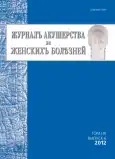Оценка эффективности сочетанного применения нефопама гидрохлорида и кетопрофена в лечении послеоперационного болевого синдрома у больных эндометриозом
- Авторы: Полушин Ю.С.1, Вартанова И.В.1, Беженарь В.Ф.1, Коростелев Ю.М.1, Голубь И.В.1
-
Учреждения:
- ФГБУ «Научно-исследовательский институт акушерства и гинекологии имени Д. О. Отта» СЗО РАМН
- Выпуск: Том 61, № 6 (2012)
- Страницы: 48-53
- Раздел: Статьи
- URL: https://journals.rcsi.science/jowd/article/view/1355
- DOI: https://doi.org/10.17816/JOWD61648-53
- ID: 1355
Цитировать
Полный текст
Аннотация
Ключевые слова
Полный текст
Открыть статью на сайте журналаОб авторах
Юрий Сергеевич Полушин
ФГБУ «Научно-исследовательский институт акушерства и гинекологии имени Д. О. Отта» СЗО РАМН
Email: polushin1@gmail.com
д. м. н., профессор, руководитель отделения анестезиологии и реанимации
Ирина Владимировна Вартанова
ФГБУ «Научно-исследовательский институт акушерства и гинекологии имени Д. О. Отта» СЗО РАМН
Email: ivartanova@mail.ru
к. м. н., научный сотрудник отделения анестезиологии и реанимации
Виталий Федорович Беженарь
ФГБУ «Научно-исследовательский институт акушерства и гинекологии имени Д. О. Отта» СЗО РАМН
Email: bez-vitaly@yandex.ru
д. м. н., профессор, руководитель отделения оперативной гинекологии
Юрий Михайлович Коростелев
ФГБУ «Научно-исследовательский институт акушерства и гинекологии имени Д. О. Отта» СЗО РАМН
Email: juko_71@mail.ru
к. м. н., старший научный сотрудник отделения анестезиологии и реанимации
Ирина Викторовна Голубь
ФГБУ «Научно-исследовательский институт акушерства и гинекологии имени Д. О. Отта» СЗО РАМН
Email: giv09@mail.ru
к. м. н., врач отделения анестезиологии и реанимации
Список литературы
- Вартанова И. В., Полушин Ю. С., Беженарь В. Ф. Оптимизация послеоперационного обезболивания больных наружным генитальным эндометриозом тяжелой степени // Журнал акушерства и женских болезней. — 2011. — Т. LX, вып. 4. — C. 26–31.
- Волчков В. А., Страшнов В. И. Актуальность исследования и лечения болевых синдромов. Обзор материалов по изучению боли // Актуальные проблемы анестезиологии, реаниматологии и интенсивной терапии: сборник. — СПб.: Изд-о СПбГМУ, 2001. — C. 16–19.
- Контроль глубины анестезии с помощью энтропии при кардиохирургических операциях / Арутюнян О. М. [и др.] //Вестник анестезиологии и реаниматологии. — 2011. — T. 8, N 6. — C. 17–23.
- Неймарк М. И. Применение кеторола в анестезиологическом обеспечении гинекологических оперативных вмешательств // Журнал акушерства и женских болезней. — 2009. — Т. LVII, вып. 5. — С. 56–57.
- Овечкин А. М. Послеоперационный болевой синдром: клинико-патофизиологическое значение и перспективные направления терапии // Consilium Medicum. — 2005. — № 6. — С. 486–490.
- Погодин С. Ю., Субботин В. В., Ситников А. В. Сравнение анальгетического действия метамизола натрия, парацетамола и кеторолака после малотравматичных оперативных вмешательств // Вестник анестезиологии и реаниматологии. — 2009. — № 6. — С. 12–16.
- Современные подходы к фармакотерапии послеоперационной боли с применением ненаркотических анальгетиков в травматологии и ортопедии / Бутров А. В. [и др.] //Consilium Medicum. — 2009. — N 9. — С. 59–62.
- Цегла Т., Готтшальк А. Лечение боли: справочник. — М.: МЕДпресс-информ, 2011. — 384 с.
- Эйвазов В. П. Обоснование оптимизации послеоперационной системной аналгезии: автореф. дис... канд. мед. наук. — М., 2005. — 18 с.
- Chronic pain following caesarean section / Nikolajsen L. [et al.] // Acta Anaesthesiol. Scand. — 2004. — Vol. 48. — P. 111–116.
- Delage N. Median effective dose (ED 50) of nefopam and ketoprofen in postoperative patients: a study of interaction using sequential analysis and isobolographic analysis // Anesthesiology. — 2005. — Vol. 102. — P. 1211–1216.
- Development of abdominal pain and IBS following gynecological surgery: a prospective, controlled study / Sperber A. D. [et al.] // Gastroenterology. — 2008. — Vol. 134, N1. — P. 75–84.
- Gatchel R. J. Early development of physical and mental deconditioning in painful spinal disorders // Contemporary conservative care for painful spinal disorders/eds T. G. Mayer, V. Mooney, R. J. Gatchel. — Philadelphia: Lea Febiger, 1991. — P. 278–289.
- Perkins F. M., Kehlet H. Chronic pain as an outcome of surgery. A review of predictive factors // Anesthesiology. — 2000. — Vol. 93. — P. 1123–1233.
- Rawal N. Organisation, function, and implementation of acute pain service // Anesthesiology. Clin. N. Am. — 2005. — Vol. 23. — P. 211–215.
- Recurrentpain after hysterectomy and bilateral salpingo — oophorectomy for endometriosis: evaluation of laparoscopic excision of residual endometriosis / Clayton R. [et al.] // Br. J. obstet. gynecol. — 1999. — Vol. 106, N. 7. — P. 740–744.
- Risk factors for chronic pain after hysterectomy: a nationwide questionnaire and database study / Brandsborg B. [et al.] //Anesthesiology. — 2007. — Vol. 106. — Р. 1003–1012.
- Surgical pleth index (SPI). Guided analgesia during sevoflurane anesthesia URL.: http://clinicaltrials.gov/ct2/show/NCT01525537.
- Treatmentrelated factors predisposing to chronic pain in patients with breast cancer — a multivariate approach / Tasmuth T. [et al.] // Acta Oncol. — 1997. — Vol. 36. — P. 625–630.
- Twenty-year history of endometriosis-associated pelvic pain: too much surgery or not enough? / Matalliotakis M. [et al.] //Am. J. Obst. Gynecol. — 2003. — Vol. 188, N. 4. — P. 1103–1104.
Дополнительные файлы







